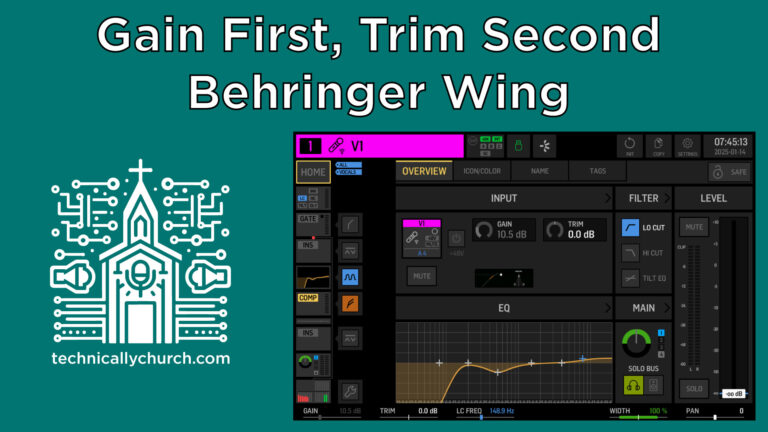Behringer Wing Tips: Batch Channel Settings with the New Bus Feed Config Screen!
Introduction:
The Behringer Wing is already a powerhouse in live sound environments, but firmware update 3.0.5 takes functionality to new heights with the Bus Feed Configuration screen. Previously, users had to adjust bus settings for each channel manually—a time-consuming and tedious process. Now, you can modify multiple channels simultaneously, making it easier than ever to set up efficient mixes for applications such as livestreaming and monitor feeds.
In this article, we’ll explore the new feature step-by-step, expand on its applications, and provide practical instructions for using its powerful functionality.
What Is the Bus Feed Configuration Screen?
The Bus Feed Configuration screen is a new addition in firmware 3.0.5 for the Behringer Wing. It provides a centralized view of all channel settings for a selected bus, allowing you to:
- Quickly see which channels are active in a bus.
- Adjust tap points, send levels, mute states, panning, and send enable status for multiple channels at once.
Let’s dive into how to use this screen, step by step.
Accessing the Bus Feed Configuration Screen
- Select a Bus:
- On the Behringer Wing console, choose the bus you wish to configure. For this example, let’s select Bus 2.
- Open the Input Section:
- On the Home screen, look beneath the Input tab. You’ll see a list of channels associated with the selected bus.
- Enter the Bus Feed Configuration Screen:
- Click on the channel list beneath Input. The Bus Feed Configuration screen will appear, displaying all channels at a glance.
Understanding the Bus Feed Configuration Screen Layout
- Grayed-out Channels: These channels are inactive in this bus.
- Lit Channels: These channels are active and contributing to the bus.
- Tap Points: You’ll see whether each channel is set to tap, post, or another tap point.
- Bulk Change Options: Modify settings for multiple channels simultaneously, including:
- Channel Mutes
- Tap Points
- Panning
- Send Enable
- Send Levels (e.g., Unity, -10 dB, or -∞)
Step-by-Step: Using the Bulk Configuration Options
1. Activating Channels in a Bus
Want to activate multiple channels on a bus at once? Here’s how:
- Highlight the desired channels (e.g., 1 through 8).
- Under Channel Mute, select Set to On.
- Click Apply to activate these channels for the bus.
Before firmware 3.0.5, this process required adjusting each channel manually, but now you can enable dozens of channels in just a few clicks.
2. Changing Tap Points for All Channels
Tap points determine at which stage the audio signal is sent to the bus:
- Highlight all the channels you want to adjust.
- Select the desired tap point (e.g., Post, Pre, or Tap).
- Click Apply to apply the change globally.
For example, if you’re setting up a bus for livestream audio, you may want all channels to be set to Post-fader, ensuring your mix dynamically follows front-of-house adjustments.
3. Adjusting Send Levels
Initial send levels can now be configured globally:
- Select all the channels or a subset of channels.
- Under Send Level, choose a preset (e.g., -∞, -10 dB, or 0 dB/Unity).
- Click Apply to set the levels.
This is especially useful for quickly configuring a bus like a livestream mix. Setting send levels to 0 dB ensures every channel starts at Unity, providing a consistent foundation for mix adjustments.
4. Enabling Sends and Configuring Panning
You can also manage channel sends and panning options:
- Use Send Enable to turn all sends On or Off.
- Adjust Panning to either:
- Follow the main channel pan, or
- Assign an independent pan for the bus.
For stereo buses, managing channel panning globally helps ensure a balanced sound without needing to tweak individual settings.
Real-World Application: Creating a Livestream Mix
Suppose you’re setting up Bus 10 for a livestream mix. Here’s how you can do it efficiently:
- Select Bus 10 and open the Bus Feed Configuration Screen.
- Highlight every channel you want in the livestream mix.
- Activate the Channels:
- Set mute state to On for all selected channels and click Apply.
- Set Tap Points:
- Configure all channels to Post-fader, ensuring changes at the main console affect the livestream mix.
- Adjust Levels:
- Set all channels to 0 dB (Unity) for a balanced starting point. Click Apply.
- Check Panning:
- Decide whether you want the bus to follow the FOH channel panning or have its own custom pan settings.
In just a few steps, you’ve prepared a fully configured mix for livestreaming, saving significant time compared to tweaking each channel manually.
Why This Feature Matters in Church Environments
Church audio setups often involve complex signal flows with multiple buses serving different needs—livestream mixes, monitor sends for the worship team, and overflow room feeds, to name a few. The new Bus Feed Configuration screen significantly reduces setup time, allowing users to focus on delivering a great worship experience instead of tedious technical tasks.
For instance:
- Monitor Mixes: Quickly mute and unmute channels for different performers.
- Overflow Rooms: Set send levels and tap points globally for consistent sound reproduction in auxiliary areas.
- Livestream: Ensure the audio mix mirrors what the congregation hears in the sanctuary.
Additional Tips:
- After making bulk changes, save your scene for easy recall in the future.
- Familiarize yourself with the different tap points (e.g., Pre, Tap, Post EQ) to ensure your mix is tailored to its purpose.
- Use color coding on the Behringer Wing to easily identify and manage your buses.
Conclusion:
Firmware 3.0.5 for the Behringer Wing redefines bus configuration with its Bus Feed Configuration screen, offering unprecedented convenience and efficiency. Whether you’re managing audio for a multichannel livestream, a worship team, or an overflow room feed, this tool empowers you to work faster and smarter. Take full advantage of this feature to streamline your workflow and deliver superior audio mixes.






